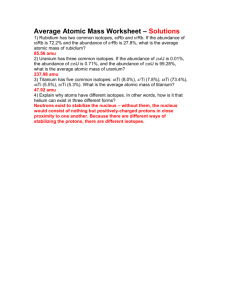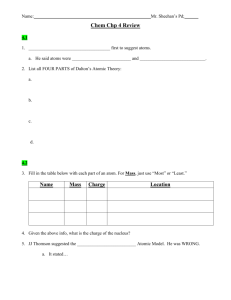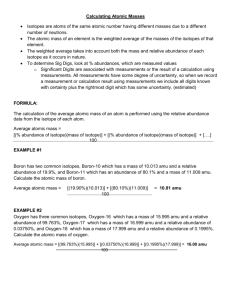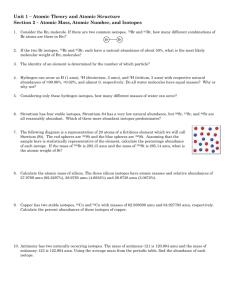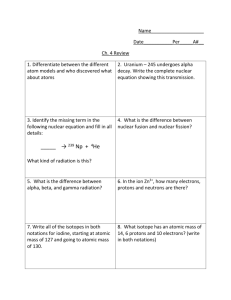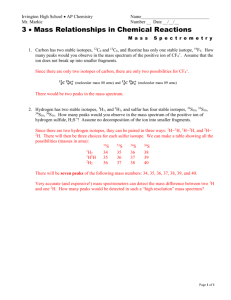Chapter 4 Homework
advertisement
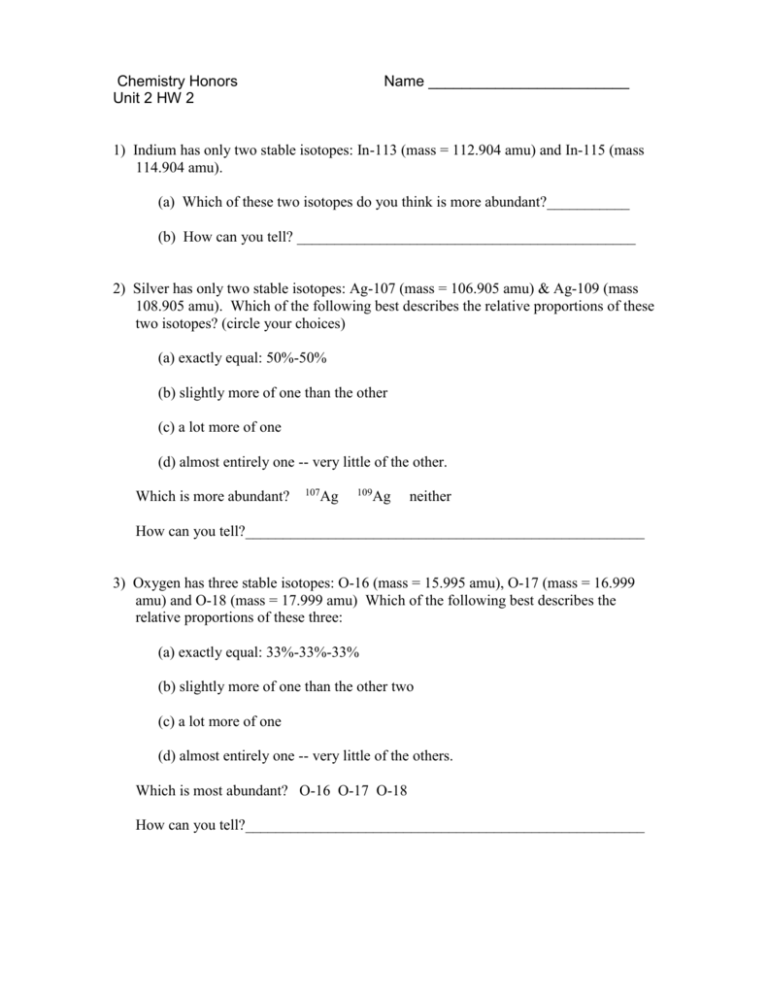
Chemistry Honors Unit 2 HW 2 Name ________________________ 1) Indium has only two stable isotopes: In-113 (mass = 112.904 amu) and In-115 (mass 114.904 amu). (a) Which of these two isotopes do you think is more abundant?___________ (b) How can you tell? _____________________________________________ 2) Silver has only two stable isotopes: Ag-107 (mass = 106.905 amu) & Ag-109 (mass 108.905 amu). Which of the following best describes the relative proportions of these two isotopes? (circle your choices) (a) exactly equal: 50%-50% (b) slightly more of one than the other (c) a lot more of one (d) almost entirely one -- very little of the other. Which is more abundant? 107 Ag 109 Ag neither How can you tell?_____________________________________________________ 3) Oxygen has three stable isotopes: O-16 (mass = 15.995 amu), O-17 (mass = 16.999 amu) and O-18 (mass = 17.999 amu) Which of the following best describes the relative proportions of these three: (a) exactly equal: 33%-33%-33% (b) slightly more of one than the other two (c) a lot more of one (d) almost entirely one -- very little of the others. Which is most abundant? O-16 O-17 O-18 How can you tell?_____________________________________________________ 4) Below is a schematic diagram of a mass spectrometer, the machine used to separate an element into its isotopes and to determine its isotopic composition. Below the diagram, in random order, are descriptions of the steps involved in the process. Match each step to the part of the machine (A – H) where that step takes place. x B 40 H 30 20 10 0 y 67 C 70 72 z F Q A 60 70 50 E D __ a series of negatively-charged rings accelerates the positively-charged ions (opposites attract) __ the beam is then passed between two oppositely-charged parallel plates __ a sample of the element (Q) is heated to vaporize it -- converting it into individual gaseous atoms __ particle detectors keep count and translate the information into a bar graph known as a mass spectrum; it shows the isotope masses on the x-axis and their relative percentages on the y-axis. __ the beam of ions is passed through two rotating disks with staggered slits -- this part of the machine allows only ions with a certain velocity to make it through __ high voltage electric current is passed through the gaseous atoms __ the ions are deflected toward the negative plate -- the lighter ones get deflected more and hit the plate sooner; the heavier ones have more momentum and hit the plate farther down. __ this knocks electrons off the atoms and changes them into positively-charged ions Where do the particles possess a variety of masses but all the same velocity? X Y Z nowhere Where do the particles possess a variety of velocities but all the same mass? X Y Z nowhere Where do the particles possess a variety of masses and a variety of velocities? X Y Z nowhere Where do the particles possess all the same mass and all the same velocity?nowhere X Y Z nowhere G 5) An element is a mixture of two isotopes. One isotope of the element has a mass of 34.96885 amu and has a percent abundance of 75.53%. The other isotope has a mass of 36.96590 amu and has a percent abundance of 24.47%. Calculate the atomic mass of the element, and use the periodic table to determine its identity. 6) The element magnesium has three isotopes with the following masses and percent abundances: Isotope Mass Abundance 24 Mg 23.9850 78.99 % 25 Mg 24.9858 10.00% 26 Mg 25.9862 11.01% Using the above data, calculate the atomic mass of magnesium. 7) Sulfur has four isotopes, with the masses and abundances given below: Isotope 32 S S 34 S 36 S 33 Mass 31.972 32.971 33.967 35.967 % Abundance 95.00 0.76 4.22 0.014 Calculate the atomic mass of sulfur using this data. 8) Lithium has two naturally occurring isotopes: lithium-6 and lithium-7. The mass of a lithium-6 atom is 6.015 amu, while a lithium-7 atom is 7.016 amu. The atomic mass of lithium is 6.941 amu. Calculate the % abundance for each of the two isotopes of lithium. (Hint: Let x = abundance of one of the isotopes; then 1-x is the abundance of the other isotope.) 9) Gallium has only two stable isotopes. One is Ga-71 (actual mass = 70.9247) and it accounts for 39.892% of all gallium. What is: (a) the percent, (b) the mass number and (c) the actual mass of the other isotope? The following problems require access to the internet! Go to the website: http://www.webelements.com/isotopes.html and click on any of the elements shown there. It will show you what the stable isotopes are, what their precise masses are and what their relative abundances are. For example, when you click of Zr, it gives you the following: Isotope Atomic mass (ma/u) 90 Zr 89.9047026 (26) 91 Zr 90.9056439 (26) 92 Zr 91.9050386 (26) 94 Zr 93.9063148 (28) 96 Zr 95.908275 (4) Natural abundance (atom %) 51.45 (40) Nuclear spin (I) 11.22 (5) 5 17.15 (8) 0 17.38 (28) 0 2.80 (9) 0 Magnetic moment (μ/μN) 0 /2 -1.30362 This tells you that Zr-90 (with an actual mass of 89.9047026 amu) accounts for 51.45% of all Zr atoms, and Zr-91 (with an actual mass of 90.9056439 amu) accounts for 11.22%, etc, etc. If we wanted to calculate the average atomic mass from this, the calculation (with no rounding from the table) would be: (89.9047026)(0.5145) + (90.9056439)(0.1122) + (91.9050386)(0.1715) + (93.9063148)(0.1738) + (95.908275)(0.0280) = 91.224 amu (which matches the value from your periodic table) 10) Repeat the above calculation using the information from the web site for one of the following: Rb, Sb, B, or Li. 11) Repeat the above calculation using the information from the web site for one of the following: Pb, Ce, Cr or Fe 12) Repeat the above calculation using the information for the web site for one of the following: Cs, Al, Bi or Au
